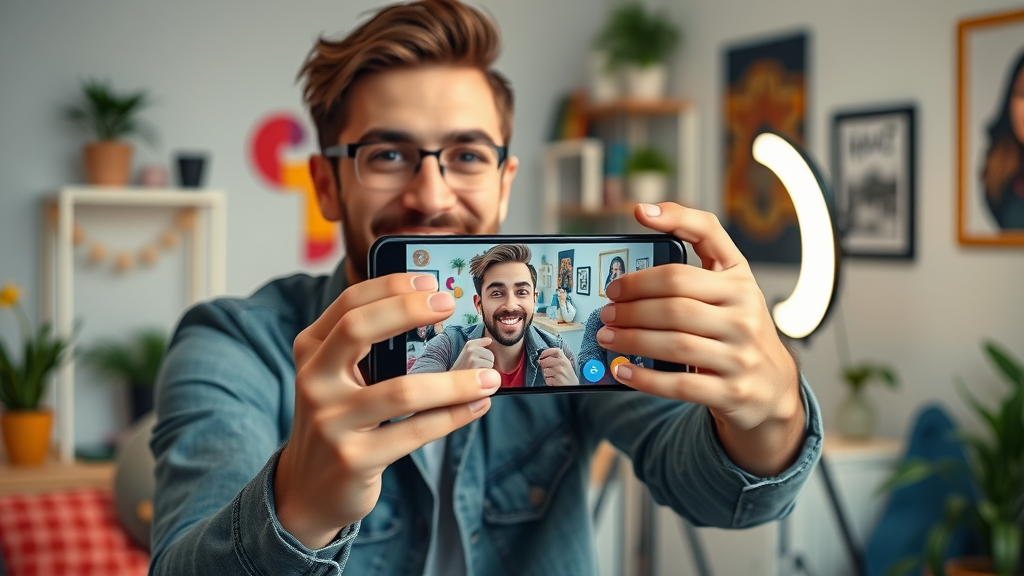Did you know that 85% of businesses struggle with ineffective social media content —and that a focused, one-day overhaul can launch your brand ahead of the competition? In today’s fast-paced media market , every social media post and content type you publish directly shapes your presence online. This article is your comprehensive guide to diagnosing and fixing social media content issues in as little as 24 hours. Get ready to transform your media content , boost content marketing results, and win over audiences on any platform, fast.

How Social Media Content Can Make or Break Your Online Presence
Social media content is now a brand’s most powerful communication tool—but it’s a double-edged sword. Effective social media posts can establish instant trust, drive conversions, and spark viral growth. On the other hand, weak or inconsistent media content can leave your brand invisible, disconnected, or even damage your reputation. Most businesses falter because they don’t align their content strategy with audience behavior or the nuances of each media platform .
If your social media content isn’t getting traction, you’re not alone. Nail-biting metrics—such as low engagement, lackluster sharing, and poor audience retention—signal that it’s time to audit your posts immediately. The good news? Nearly all social media content issues are fixable, and with a structured process, meaningful improvements are possible within just 24 hours. In this guide, you’ll uncover fast, practical steps and actionable examples to create winning content types and build your way to sustained brand awareness .
- Discover why 85% of businesses struggle with ineffective social media content and how you can turn this around in a single day. Learn how to identify problem areas, apply quick fixes, and develop long-term strategies for lasting success on every social media platform you use.
The Fast-Track Guide to Effective Social Media Content

Why Social Media Content Matters in Content Marketing and Media Marketing
The value of social media content in today’s media market cannot be overstated. Platforms like Instagram, Facebook, and TikTok are where content marketing comes alive, exposing your brand to global audiences in seconds. Each social media post helps shape audience perception and builds (or erodes) trust. Lively, authentic, and consistent content types foster connections and stimulate brand awareness , fueling a robust media marketing presence that outlasts fleeting trends.
But it’s not just about showing up; it’s about staying relevant. The right mix of media content keeps your audience engaged and signals to platform algorithms that your voice matters. From video content and infographics to user-generated content , each content format has a role. When you continuously deliver high-quality and targeted posts, your marketing strategy gains momentum—boosting clicks, comments, and conversions.
How to Identify Key Weaknesses in Your Social Media Content Strategy
Pinpointing flaws in your content strategy starts with an honest media content audit. Start by measuring engagement rates—if your social media content consistently receives fewer views, likes, or shares than expected, or if your follower growth has stalled, these are warning flags. Scrutinize your content types: Are you relying too heavily on text-based posts when your audience craves video content or polls? Are your media posts aligned with your brand voice and targeting the right platforms?
Common missteps include inconsistent posting, ignoring platform algorithms , or mismatched messaging across channels. Reviewing the performance of different content formats and analyzing which media platforms bring in actual engagement will help you zero in on problem areas quickly. Don’t ignore user feedback , either; listen to your audience’s comments and suggestions to reshape your approach.
| Common Issues | High-Performing Content Features |
|---|---|
| Irregular posting schedules | Consistent, scheduled content calendar |
| Overly promotional posts | Value-driven, educational, or entertaining content |
| Lack of visuals or video content | Engaging images, videos, infographics |
| Mismatched brand voice | Unified, authentic messaging |
| Ignored analytics and feedback | Data-backed strategy adjustments |
Critical Content Types for Social Media Marketing Success
Not all content types perform the same on every media platform . To drive engagement and outperform competitors, it’s essential to diversify what you share. High-performing media posts leverage a mix of creativity and strategy, ranging from bite-sized video content to interactive quizzes that spark real conversations. Understanding which types of content prompt the best responses empowers you to fine-tune your creation process for every social media market .
Consider the preferences of your target audience: younger users may gravitate toward viral form video on TikTok, while business professionals engage more with thought leadership articles on LinkedIn. The goal is to blend user-generated content with other innovative formats to build trust, foster interaction, and boost visibility in any media market .
- Video Content (Short-form video, Live streams)
- Infographics and Visual Posts
- User-Generated Content
- Educational & Value-based Posts
- Interactive Content (Polls, Quizzes, Q&A)
- Story-Based Content

The Role of Video Content on Social Media Platforms
Video content reigns supreme in the social media market , consistently outperforming static images or text in grabbing attention and improving retention. Platforms like Instagram Reels, TikTok, and Facebook Live prioritize form video in their feeds, making it essential for brands looking to stay visible. Short, punchy video content quickly communicates your message while showcasing your brand’s creativity in a format audiences love to share and comment on.
Leveraging different types of content within video content —from live Q&A sessions to behind-the-scenes clips—builds a stronger brand voice and boosts audience engagement. Even a simple product demo video can generate lasting impact in your content marketing strategy, converting scrollers into loyal followers or customers. Ultimately, prioritizing video content ensures a better fit with evolving media platform algorithms and shifting audience tastes.
How Generated Content Boosts Media Content Reach
User-generated content unleashes the power of your own community to amplify your message. When fans or customers share photos, testimonials, or stories about your brand, that media content gains authenticity and reaches far beyond what traditional advertising can provide. This evolving content strategy builds social proof and trust, showing potential customers genuine use cases and experiences.
The most effective social media brands encourage user submissions, contests, or branded hashtags to inspire media posts that naturally multiply reach. By celebrating generated content , you not only expand your audience organically but also receive valuable insights about how your content formats resonate in the real world. Integrating these posts into your regular schedule maximizes every campaign’s impact, especially in crowded social media markets .
Step-by-Step Process: Fixing Your Social Media Content in 24 Hours
Tackling social media content issues swiftly requires a systematic approach. From conducting a comprehensive audit to adjusting your content types in real-time, rapid transformation is entirely possible—no matter how scattered your current feeds may seem. Here’s a proven formula to revolutionize your media content fast and set a course for sustainable success.
Each step focuses on practical, actionable changes: from pinpointing what’s not working to rapidly implementing new strategies. Setting focused goals, optimizing your content calendar , and leveraging media marketing insights for ongoing improvements mean your brand can truly stand out—on every social media platform you use.
- Social Media Content Audit on Every Media Platform
- Setting Quick Goals for Content Marketing Results
- Crafting a Real-Time Content Calendar
- Revising Content Types Based on Data
- Leveraging Media Marketing Insights for Optimization

Creating a Rapid Response Content Strategy
When time is limited, an agile content strategy is your secret weapon. Begin by identifying the most pressing media content gaps—whether it's lack of engagement, missing content types , or unclear messaging. Move quickly to prioritize actions that have immediate impact: schedule a series of engaging video content , refresh your brand voice in captions, or reshape your social media posts to focus on real-time trends.
Use a flexible content calendar to plan updates hour-by-hour, and assign responsibilities to your team for maximum efficiency. By organizing posts by media platform and tailoring each to your target audience , you’ll see measurable improvements overnight. A focused 24-hour push—using the right mix of content formats —can reset failing marketing efforts and lay a strong foundation for ongoing growth.
How to Repurpose Old Content for New Social Media Market Demands
Fresh ideas aren’t always necessary—sometimes the fastest fix is to give your existing media content a new spin. Audit your archive for top-performing content types from the past and adapt them for new social media platforms or emerging form video trends. Turn a forgotten blog post into a lively infographic, convert a successful infographic into bite-sized video content , or adapt testimonials into eye-catching stories.
Repurposing also saves time in tight deadlines. Update old data, refresh the design, and relaunch with new hashtags or messaging that fits current media marketing strategies. This approach boosts your content marketing ROI by maximizing every asset you’ve already created and aligning your media content with fast-changing social media market standards.
Building a Sustainable Social Media Content Calendar
Consistency is the foundation of any effective social media presence. A well-planned content calendar helps you schedule, organize, and diversify media posts across multiple media platforms . It ensures that your audience receives regular value and that your content strategy supports both short-term campaigns and long-term goals.
Map out each type of content —such as short video , educational posts, or user stories—and align them with key dates, launches, or events. This structured approach gives your team clear direction, prevents overlooked opportunities, and smoothes collaboration. A vibrant content calendar balances steady routine with agile updates to respond to trends and analytics insights as they emerge.
| Time | Platform | Content Type | Notes |
|---|---|---|---|
| 9AM | Story (User-Generated Content) | Feature fan testimonial | |
| 12PM | Poll (Interactive Content) | Trending question for audience input | |
| 3PM | Video Content (Short-Form) | Product demo highlight | |
| 6PM | TikTok | Live Stream | Q&A session with influencer |
"Consistency beats virality in the long run. A planned social media content calendar is your path to sustainable engagement."

Optimizing Social Media Content for Major Social Media Platforms
Each social media platform comes with its own algorithms, audience, and preferred content formats . What thrives on Facebook may flop on TikTok, and lengthy LinkedIn posts won’t stick on Instagram. Customizing your media content for each channel is not just a smart move—it’s the key to unlocking maximum reach, resonance, and ROI.
Experiment with several types of content until you find the winning mix for your target audience . Use analytics to iterate, noting which content types draw the best clicks and which time slots boost visibility for each social media post .
Customizing Content for Facebook, Instagram, LinkedIn, Twitter, and TikTok
For Facebook, blend video content , community polls, and value-focused posts to drive comments and shares. Instagram shines when you use story-based content and eye-catching visuals, such as infographics and behind-the-scenes media posts . LinkedIn requires a more professional, thought-leadership slant—try sharing case studies, educational content , and industry news that reinforce your expertise.
On Twitter, short-form updates, trending memes, and live event coverage thrive. TikTok, meanwhile, rewards creativity and authenticity: jump on viral audio trends, use looped short video content, and keep posts energetic and personal. No matter the platform, tailoring content to fit the culture and format of its user base is essential for standing out in a crowded social platform ecosystem.
Why Platform Algorithms Reward Certain Media Content Types
Social media platform algorithms are engineered to prioritize content that sparks interactions and keeps users engaged. Form video —especially when it generates rapid comments or shares—quickly climbs in feeds, while generic or passive posts may get buried. Visual elements, frequent updates, and interactive media posts like polls or quizzes are more likely to be surfaced by algorithms seeking to maximize user attention.
Staying in tune with evolving algorithm changes helps you craft a smarter content strategy . By experimenting with new content types and analyzing real-time insights, you’ll align each social media post with what platforms favor, keeping your media marketing efforts ahead of the curve.

Leveraging Content Strategy for Stronger Social Media Marketing ROI
A well-planned content strategy pays off in higher media marketing returns—if you measure it correctly. Tracking the right social media metrics helps you understand what’s working and what needs improvement. Focus on metrics like engagement rate, click-through rate, reach, and conversion to tie your social media content to concrete marketing objectives.
Invest in tools that automate data collection and reporting for each media platform . Reviewing weekly or monthly trends allows for quick pivots that align with audience behavior and shifting content marketing priorities. The more you fine-tune your approach using real results, the stronger your media content ROI becomes.
Measuring Social Media Content Performance with Key Metrics
Success on social media platforms isn’t just about posting more—it’s about optimizing for the metrics that matter. Track likes, shares, comments, and saves to gauge surface-level interest, but dig deeper into metrics like average watch time for video content or traffic driven to your site from media posts . Use these insights to adjust your content strategy , doubling down on high performers and phasing out underachieving posts.
| Metric | Description | Why It Matters |
|---|---|---|
| Engagement rate | Combined likes, shares, and comments per post | Reveals audience resonance and content quality |
| Reach | Number of unique users who saw your content | Measures potential brand awareness |
| Click-through Rate (CTR) | Percentage of viewers who clicked links | Shows how compelling your call-to-action is |
| Conversion rate | Percent of users who completed a desired action | Directly ties media marketing to business results |
| Audience growth | Change in followers over time | Indicates successful content marketing or viral effects |
Top Trends in Social Media Content and Content Types for 2024
The media market evolves rapidly. In 2024, several trends are taking center stage: short-form video , AI-powered generated content , and deep engagement within niche communities dominate strategies for both emerging and established brands. Interactive formats, like shoppable posts and social audio, are bridging the gap between brands and their target audience in ways that feel more personal and direct than ever before.
To stay ahead, monitor and experiment with these rising types of content , investing time in formats that build loyal communities and ease the path to purchase right from your media posts . Being early to new content types can help you ride the next big wave in content marketing success.
- Short-Form Video Dominance
- AI-Generated Content
- Niche Community Engagement
- Interactive and Shoppable Posts
- Social Audio and Podcasts

Adapting Your Content Types to Changing Audience Behaviors
As the social media market landscape shifts, so do user behaviors and expectations. The platforms and content types that were trending last year might not hold the same power now. Regularly analyze your audience demographics, feedback, and analytic trends to adapt your media content production accordingly.
Always be ready to pivot: if your audience migrates toward new platforms or shows a preference for stories over static posts, adjust your content calendar overnight. Staying responsive to these changes is the hallmark of an effective social media content strategy and leads to stronger engagement and lasting loyalty.
Expert Tips for Managing Social Media Content Crisis Situations
No matter how careful you are, a social media content crisis can strike unexpectedly—a poorly timed media post , a misinterpreted campaign, or negative viral feedback. The brands that bounce back fastest have a clear crisis response plan built into their content strategy . Acting with transparency and a unified brand voice can turn mistakes into opportunities to rebuild trust and even strengthen your public image.
Prepare for the unexpected by training your team, setting up social listening alerts, and having approved messaging templates for rapid response. In an emergency, act fast but deliberately, focusing on authenticity and customer care above all.
- How to Recover from a Viral Content Flop
- Steps to Maintain Brand Voice in Media Content Emergencies
- Using Content Strategy to Rebuild Trust Quickly
"In social media marketing, perception can shift in moments. A strong content strategy is your safety net."

Real-World Examples: Social Media Content Turnarounds
Incredible transformations are possible, no matter your starting point. Here are two real-world case studies where brands not only patched up social media content issues but skyrocketed their media marketing results within days.
Case Study: Rapid Social Media Content Makeover in Health & Wellness
A mid-sized wellness brand noticed declining engagement across its media platforms . They performed a 24-hour audit, identified underperforming content types , and swapped text-heavy media posts with fresh video content and user-generated stories. Within a week, engagement rates doubled, and customer feedback became overwhelmingly positive, proving that the right content format can rescue even a struggling brand in a competitive media market .
Their strategy also included clearer calls-to-action on every social media post and a focus on educational materials that their target audience valued most. This renewed focus positioned them as a market leader in health advice and wellness education.
Case Study: Multi-Platform Media Marketing Success in E-Commerce
An e-commerce startup expanded from Instagram-only selling to a full-fledged, multi-channel media marketing operation. By adapting each content type —short videos for TikTok, professional testimonials for LinkedIn, and shoppable posts for Facebook—they witnessed a 60% increase in conversions and robust audience growth.
The team also leveraged user-generated product reviews as media content across all platforms, boosting authenticity and dramatically improving trust signals for potential buyers. This turnaround highlights how versatile content formats and a unified content calendar fuel e-commerce success in any social media market .

The 12 Essential Tools for Faster Social Media Content Creation and Scheduling
Having the right tools on hand supercharges your ability to audit, revise, and amplify social media content at lightning speed. Whether you need design support, scheduling automation, or deep-dive analytics, these essential solutions streamline every step. Investing in just a handful of these resources can turn a hectic content calendar into a well-oiled marketing strategy .
- Canva (Visual Content)
- Hootsuite (Scheduling)
- Buffer (Publishing)
- Later (Media Platform Optimization)
- SproutSocial (Analytics)
- Google Trends (Content Ideas)
- Grammarly (Editing)
- Lumen5 (Video Content Creation)
- Trello (Content Calendar)
- SEMrush (Content Marketing Research)
- BuzzSumo (Social Media Trends)
- AnswerThePublic (Topic Generation)

Frequently Made Mistakes in Social Media Content and Content Marketing
Even seasoned brands slip into common social media content traps. Avoiding these pitfalls means holding your media posts to higher standards and staying adaptable in your content marketing approach. Pay close attention to quality assurance and never let analytics or audience feedback slide.
- Over-promoting Products or Services
- Ignoring Social Media Platform Differences
- Inconsistent Media Content Quality
- Failing to Analyze Metrics
- No Clear Content Strategy
How to Build an Effective Social Media Content Strategy from Scratch
If you’re starting fresh or rebuilding, designing a content strategy is vital. First, set clear social media marketing goals—do you want more followers, site traffic, or sales? Next, dive into audience and platform analysis to uncover habits and preferences. Choose the content types that best fit your target audience and business goals, create a consistent content calendar , then monitor results and adapt using analytics insights.
- Define Social Media Marketing Goals
- Analyze Audience Behavior on Media Platforms
- Select Core Content Types
- Establish a Content Calendar
- Monitor and Adjust Using Media Marketing Analytics
Watch this short video summarizing the five most critical social media content mistakes and actionable fixes, including engaging transitions and concise visual explanations.
Evaluate your posts with expert techniques to spot issues and apply fast improvements that get immediate results.
Learn how to design a flexible content marketing strategy that adapts to every platform and audience for ultimate impact.
Frequently Asked Questions about Social Media Content
-
Q1: What type of content is on social media?
A1: Social media content includes videos, images, stories, user-generated posts, infographics, and written articles, tailored to the platform’s audience preferences. -
Q2: What is the 5 5 5 rule on social media?
A2: The 5 5 5 rule encourages sharing five pieces of your own content, five pieces of curated content from others, and five interactions (such as comments or shares) per week to maintain a balanced social media presence. -
Q3: What is the best content for social media?
A3: The best social media content delivers value, entertains, and encourages interaction. Video content, interactive stories, and educational posts are highly effective across media platforms. -
Q4: What are the four types of social media content?
A4: The four main types are: Educational, Inspirational, Entertaining, and Conversational content.
Key Takeaways for Fixing Social Media Content Issues
- Social media content must be tailored to each platform and audience.
- Quick audits and strategic content fixes lead to immediate improvements.
- Consistency in content marketing wins long-term engagement.
- Leveraging the right tools accelerates results.
Ready to Transform Your Social Media Content? Take the First Step Today
Don’t let another day pass with weak social media content—start your audit now and experience rapid, measurable results!
To enhance your social media content strategy, consider exploring the following resources:
-
“Maximizing Reach and Engagement: Social Media Content Tips” : This article offers practical advice on creating concise, value-driven content and emphasizes the importance of strategic scheduling to optimize audience engagement. ( coschedule.com )
-
“Effective Social Media Content Strategies for 2024” : This resource delves into the significance of user-generated content and educational materials, providing insights into how these elements can build trust and position your brand as an industry authority. ( vistasocial.com )
By integrating these strategies, you can refine your content approach, foster deeper connections with your audience, and achieve measurable improvements in your social media performance.
 Add Row
Add Row  Add
Add 


Write A Comment